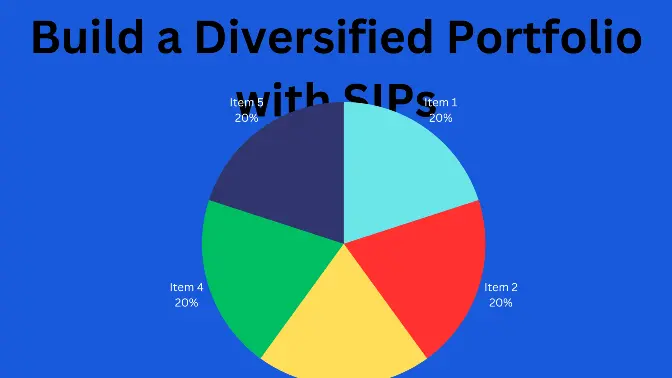Systematic Investment Plans (SIPs) have revolutionized the way individuals invest in mutual funds.
They offer a simple, disciplined, and hassle-free approach to investing, making it easy for anyone to participate in the financial markets.
A well-constructed SIP portfolio can provide an investor with steady returns and help them achieve their financial goals.
In this blog post, we will discuss the importance of building a diversified SIP portfolio and offer a step-by-step guide to help you create your own successful investment strategy.

Understanding SIPs:
A SIP is a method of investing in mutual funds wherein a fixed amount is invested regularly, typically monthly, in a chosen mutual fund scheme.
The primary advantage of investing through SIPs is that it allows investors to average out the cost of investment over time, reducing the impact of market fluctuations.
By staying disciplined and consistent, SIPs enable investors to benefit from the power of compounding, which can lead to significant wealth creation in the long run.
Importance of a Diversified SIP Portfolio:
A diversified portfolio is essential in minimizing risk and optimizing returns. By investing in a variety of asset classes, sectors, and geographies, you can reduce the impact of a poor-performing investment on your overall portfolio.
A well-diversified SIP portfolio not only offers stability and balance but also provides exposure to a broader range of growth opportunities.
Steps to Build a Diversified SIP Portfolio:
Define your investment goals and time horizon:
Before starting to build your SIP portfolio, it is essential to identify your financial goals and the time frame in which you wish to achieve them.
For instance, you may want to save for your child’s education, your retirement, or purchasing a home.
Your goals and time horizon will determine your risk appetite and guide your investment decisions.
Assess your risk tolerance:
Risk tolerance refers to the level of risk you are willing to take with your investments.
It is crucial to evaluate your risk tolerance based on factors such as your age, financial situation, and investment goals.
Generally, younger investors with a longer investment horizon can afford to take more risks, while older investors nearing retirement should lean towards a more conservative approach.
Select the right asset classes:
Diversification begins with allocating your investments across different asset classes.
These include equity, debt, gold, and real estate, among others.
The proportion of each asset class in your SIP portfolio should be based on your investment goals, risk tolerance, and time horizon.
For instance, a high-risk investor with a long-term investment horizon may opt for a higher allocation to equity, while a risk-averse investor might prefer more significant exposure to debt instruments.
Choose the right mutual fund schemes:
Once you have decided on the asset allocation, the next step is to select the appropriate mutual fund schemes for your SIP portfolio.
It is vital to choose funds with a consistent performance history, managed by experienced fund managers, and with a reasonable expense ratio.
Moreover, ensure that the chosen schemes align with your risk profile and investment goals.
Diversify within asset classes:
For a truly diversified SIP portfolio, it is crucial to diversify not only across asset classes but also within each asset class.
In the case of equities, diversify across market capitalizations (large-cap, mid-cap, and small-cap), sectors, and themes.
For debt funds, diversify across credit quality, duration, and issuer types.
This will help spread the risk and increase the potential for higher returns.
Regularly review and rebalance your portfolio:
The performance of various asset classes and mutual fund schemes may change over time. It is essential to review
your SIP portfolio periodically, ideally once a year, to ensure that it remains aligned with your investment goals and risk tolerance.
Rebalancing involves adjusting the allocation of different asset classes and mutual fund schemes in your portfolio.
This may include adding new funds, exiting underperforming ones, or adjusting the weightage of specific assets.
Regular review and rebalancing will help you stay on track to achieve your financial objectives.
Benefits of a Diversified SIP Portfolio:
Reduces overall risk:
A diversified SIP portfolio reduces the overall risk by spreading investments across various asset classes, sectors, and geographies.
This ensures that poor performance in one segment does not adversely impact the entire portfolio.
Optimizes returns:
Diversification allows investors to tap into a broader range of growth opportunities, which can lead to higher returns over time.
By investing in different asset classes and sectors, investors can benefit from varying growth cycles and maximize their overall returns.
Provides flexibility:
A diversified SIP portfolio offers the flexibility to adjust the allocation of assets based on changing market conditions, risk tolerance, and investment goals.
This flexibility enables investors to adapt their investment strategy and optimize their portfolio’s performance.
Facilitates disciplined investing:
SIPs instill a disciplined approach to investing, as they require a fixed amount to be invested at regular intervals.
This helps investors stay committed to their investment plan, even during periods of market volatility and ultimately leads to long-term wealth creation.








